Greenwich
District Hospital
Vanbrugh Hill, Greenwich, SE10 9JH
Medical
dates:
Medical
character:
General. Later, acute
The
Greenwich and Deptford workhouse opened in 1840 on a 4 acre site at the
east side of
Vanbrugh Hill. Originally designed to
accommodate 650 fit and 200 ill paupers, by 1851 the average number of
inmates was over 1000.
By the 1870s it had become increasingly necessary to provide medical care and, in 1874, plans were drawn up for a new infirmary block so that space could be freed up in the south block of the workhouse for able-bodied inmates.
The Greenwich Union Infirmary opened in 1876 and consisted of two 3-storey pavilions, which could house 400 patients, and a 4-storey administration block, which also contained staff accommodation. It had cost £35,000 and occupied a 3-acre site immediately south of the workhouse.
In 1885 the Board of Guardians raised £14,800 from the Metropolitan Board of Works so that alterations could be made to the workhouse and two more infirmary blocks be built to house about 300 chronically sick inmates. In 1889, a further two blocks for both sexes were added for 250 patients. How bed numbers were split at this stage between workhouse and infirmary appears a little fluid. By 1891, however. with a certified accommodation of 538 beds, the infirmary had an average daily occupation of some 380 patients. The overgenerous facilities available for the acutely ill were contrasted by the permanent state of overcrowding in the workhouse. Prospective inmates were sent to neighbouring unions under a reciprocal exhange scheme, and younger inmates were persuaded to emigrate to the Colonies and to the Dominion of Canada at the expense of the parish rate-payers. In 1898 the Infirmary was certified as a Training School for Nurses, with some 40-50 girls in training. By the turn of the century it was beginning to become a general hospital with a staff of 150, including a medical officer and 60 nurses of varying grades. The acute beds were open not only to paupers of the parish but also to those who could afford to pay for them.
Between 1918 and 1929 the spartan conditions in the Infirmary were gradually improved; the walls were plastered and central heating and electrical lighting installed. X-ray and Massage Departments were established.
In 1927 Princess Mary, Viscountess Lascelles, officially opened the Woodlands Nurses' Home. In 1928 an operating theatre was installed.
In 1929 responsibility for the administration of the workhouse and infirmary was transferred to the LCC, and it was renamed the Greenwich and Deptford Hospital. By then the workhouse part contained 846 beds for the chronic sick and the infirmary 645 beds for acute patients.
In 1930 a ward for tuberculosis patients was built , as well as a new Out-Patients Department with a pharmacy, antenatal clinic and nurses' sick bay facility. In 1931 the Hospital was renamed St Alfege's Hospital, after Alfege, Archbishop of Canterbury, who was murdered by Danish pirates at Greenwich in 1012.
By 1944 the Hospital still remained divided into two parts: St Alfege's Hospital I (the infirmary) had acute 618 beds and St Alfege's II (the former workhouse) had 498 beds for long-stay patients.
In 1948 the Hospital joined the NHS under the control of the South East Metropolitan Regional Hospital Board. It had 553 beds in St Alfege's I and 284 beds in St Alfege's II.
By 1954 there were 268 beds for acute patients in the southern (infirmary) buildings and 366 beds for geriatric and long-stay patients in the northern (workhouse) buildings. By 1956 the Hospital was experiencing staff shortages and 103 beds had to be closed.
In 1960 the Regional Hospital Board decided that the distinction between the two St Alfege's Hospitals would cease and that they would merge into one unit of 605 beds.
As part of the modernisation of the NHS, a new hospital was planned to replace the existing one; it was to be designed by the Hospital Design Unit of the Ministry of Health. Work began in 1965 at the northwest cormer of the site, which had been cleared of buildings damaged during bombing in WW2. The plan was to demolish the old buildings gradually and build the new ones while keeping the Hospital operational. Many units of the new hospital would be prefabricated in the factory and assembled on site. Phase 1 of the project was completed in 1969, Phase 2 by the end of 1970 and Phase 3 by 1972.
The new three-storey Hospital opened in 1972, having cost £6m. It was renamed Greenwich District Hospital and had 800 beds.
The lower ground floor contained the supply and maintenance departments for the entire Hospital. All supplies were delivered to this area, then transported via trolley trains to individual wards and departments. Waste for disposal was returned by the same means. The ground floor contained the Out-Patients Department, an operating theatre and a day ward, and geriatric and psychiatric Day Hospitals. The wards on the floors above were situated along the outside walls of the rectangular building, with the service departments, such as X-ray, pathology laboratories and operating theatres in the centre, with no natural light. None of the windows opened and the entire building was ventilated mechanically. Each floor, except the lower ground floor, had its own kitchen.
Mechanical problems with the innovative trolley conveyor system, the air-conditioners and the escalators between floors meant they required regular servicing.
Although the Hospital had been designed to take an extra floor, the beam spans used were too wide and the sags meant that the corbels were inadequate. The plan to add a fourth floor was never realised.
During the late 1980s some £6m was spent on removing asbestos from the voids between the floors.
The Hospital closed in March 2001, with 583 beds. All services were transferred to the Queen Elizabeth Hospital in Woolwich.
Present status (February 2008)
The Hospital was demolished in 2006 following its sale to English Partnerships for £18m. The site is now a wasteland and is awaiting redevelopment as a housing complex.
Update: September 2013
It was announced in April 2013 that the site, taken over by the Mayor of London in 2012, is to be redeveloped by Hadley Mace into a housing scheme with 645 residences, over half of which will be 'affordable'. The £225m development will be known as Greenwich Square.
By the 1870s it had become increasingly necessary to provide medical care and, in 1874, plans were drawn up for a new infirmary block so that space could be freed up in the south block of the workhouse for able-bodied inmates.
The Greenwich Union Infirmary opened in 1876 and consisted of two 3-storey pavilions, which could house 400 patients, and a 4-storey administration block, which also contained staff accommodation. It had cost £35,000 and occupied a 3-acre site immediately south of the workhouse.
In 1885 the Board of Guardians raised £14,800 from the Metropolitan Board of Works so that alterations could be made to the workhouse and two more infirmary blocks be built to house about 300 chronically sick inmates. In 1889, a further two blocks for both sexes were added for 250 patients. How bed numbers were split at this stage between workhouse and infirmary appears a little fluid. By 1891, however. with a certified accommodation of 538 beds, the infirmary had an average daily occupation of some 380 patients. The overgenerous facilities available for the acutely ill were contrasted by the permanent state of overcrowding in the workhouse. Prospective inmates were sent to neighbouring unions under a reciprocal exhange scheme, and younger inmates were persuaded to emigrate to the Colonies and to the Dominion of Canada at the expense of the parish rate-payers. In 1898 the Infirmary was certified as a Training School for Nurses, with some 40-50 girls in training. By the turn of the century it was beginning to become a general hospital with a staff of 150, including a medical officer and 60 nurses of varying grades. The acute beds were open not only to paupers of the parish but also to those who could afford to pay for them.
Between 1918 and 1929 the spartan conditions in the Infirmary were gradually improved; the walls were plastered and central heating and electrical lighting installed. X-ray and Massage Departments were established.
In 1927 Princess Mary, Viscountess Lascelles, officially opened the Woodlands Nurses' Home. In 1928 an operating theatre was installed.
In 1929 responsibility for the administration of the workhouse and infirmary was transferred to the LCC, and it was renamed the Greenwich and Deptford Hospital. By then the workhouse part contained 846 beds for the chronic sick and the infirmary 645 beds for acute patients.
In 1930 a ward for tuberculosis patients was built , as well as a new Out-Patients Department with a pharmacy, antenatal clinic and nurses' sick bay facility. In 1931 the Hospital was renamed St Alfege's Hospital, after Alfege, Archbishop of Canterbury, who was murdered by Danish pirates at Greenwich in 1012.
By 1944 the Hospital still remained divided into two parts: St Alfege's Hospital I (the infirmary) had acute 618 beds and St Alfege's II (the former workhouse) had 498 beds for long-stay patients.
In 1948 the Hospital joined the NHS under the control of the South East Metropolitan Regional Hospital Board. It had 553 beds in St Alfege's I and 284 beds in St Alfege's II.
By 1954 there were 268 beds for acute patients in the southern (infirmary) buildings and 366 beds for geriatric and long-stay patients in the northern (workhouse) buildings. By 1956 the Hospital was experiencing staff shortages and 103 beds had to be closed.
In 1960 the Regional Hospital Board decided that the distinction between the two St Alfege's Hospitals would cease and that they would merge into one unit of 605 beds.
As part of the modernisation of the NHS, a new hospital was planned to replace the existing one; it was to be designed by the Hospital Design Unit of the Ministry of Health. Work began in 1965 at the northwest cormer of the site, which had been cleared of buildings damaged during bombing in WW2. The plan was to demolish the old buildings gradually and build the new ones while keeping the Hospital operational. Many units of the new hospital would be prefabricated in the factory and assembled on site. Phase 1 of the project was completed in 1969, Phase 2 by the end of 1970 and Phase 3 by 1972.
The new three-storey Hospital opened in 1972, having cost £6m. It was renamed Greenwich District Hospital and had 800 beds.
The lower ground floor contained the supply and maintenance departments for the entire Hospital. All supplies were delivered to this area, then transported via trolley trains to individual wards and departments. Waste for disposal was returned by the same means. The ground floor contained the Out-Patients Department, an operating theatre and a day ward, and geriatric and psychiatric Day Hospitals. The wards on the floors above were situated along the outside walls of the rectangular building, with the service departments, such as X-ray, pathology laboratories and operating theatres in the centre, with no natural light. None of the windows opened and the entire building was ventilated mechanically. Each floor, except the lower ground floor, had its own kitchen.
Mechanical problems with the innovative trolley conveyor system, the air-conditioners and the escalators between floors meant they required regular servicing.
Although the Hospital had been designed to take an extra floor, the beam spans used were too wide and the sags meant that the corbels were inadequate. The plan to add a fourth floor was never realised.
During the late 1980s some £6m was spent on removing asbestos from the voids between the floors.
The Hospital closed in March 2001, with 583 beds. All services were transferred to the Queen Elizabeth Hospital in Woolwich.
Present status (February 2008)
The Hospital was demolished in 2006 following its sale to English Partnerships for £18m. The site is now a wasteland and is awaiting redevelopment as a housing complex.
Update: September 2013
It was announced in April 2013 that the site, taken over by the Mayor of London in 2012, is to be redeveloped by Hadley Mace into a housing scheme with 645 residences, over half of which will be 'affordable'. The £225m development will be known as Greenwich Square.
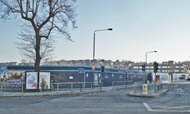
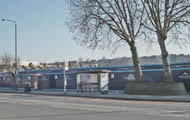
A blue hoarding now surrounds the vacant site.
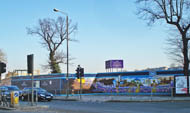
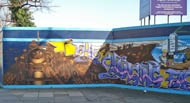
Local history is illustrated on the hoarding. The message proclaims 'The changing face of East Greenwich', although the only thing that has changed so far is that the Hospital was demolished three years ago.
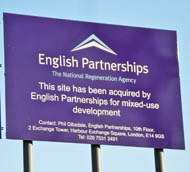
The site now belongs to the government's national regeneration agency, English Partnerships.
In
1934 Dr. Mary Walker, a Medical Officer at the Hospital, observed that
the signs and symptoms of myasthenia
gravis, a neuromuscular disorder, were similar to those of
curare poisoning. She discovered that physostigmine,
used as an
antidote for curare poisoning, could also temporarily restore muscle
function in patients with myasthenia gravis. The first case to be
successfully treated by subcutaneous injection was reported in the Lancetin
June 1934. Dr. Walker and others developed the drug so that it
could be taken orally (subcutaneous administration of physostigmine had
serious side-effects). Oral prostigmin, a
synthetic drug closely related chemically and pharmacologically to
physostigmine, is used today in the treatment of
myasthenia gravis.
Lee MR 2007 The miracle of St Alfege's: seventy years on. Journal of the Royal Society of Medicine 100, 108-109.
Moss R, Thomas H 1966 St Alfege's Hospital. Greenwich and Deptford Union Workhouse and Infirmary. British Medical Journal 2 (5529), 1587-1589.
Walker MB1934 Treatment of myasthenia gravis with physostigmine. Lancet (i), 1200-1201.
Personal communication: Dr Andrew Bamji
http://en/wikipedia.org
http://greenwichrising.com
http://hansard.millbanksystems.com
www.aim25.ac.uk
www.communityplanning.net
www.derelictlondon.com
www.flickr.com
www.geograph.org.uk (1)
www.geograph.org.uk (2)
www.geograph.org.uk (3)
www.newshopper.co.uk
www.thegreenwichphantom.co.uk
www.youtube.com
www.workhouses.org.uk
Return to home page